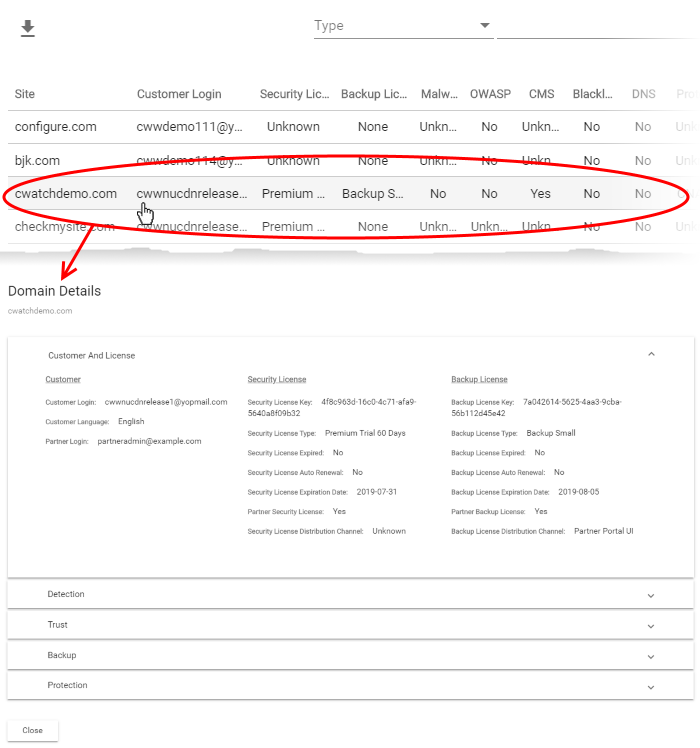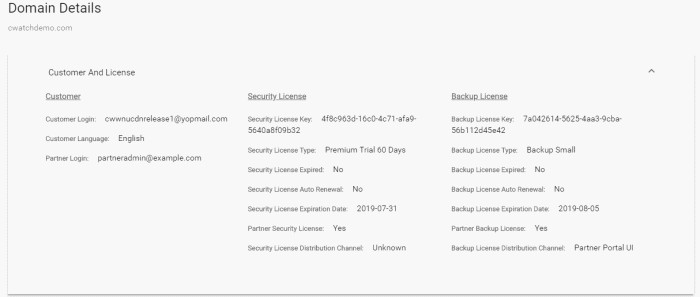View Domain Details of a Website
- Click the 'Domain Overview' tab
- Click on the domain whose details you want to view:

The 'Domain Details' screen has
five tabs:
- Customer and License - Customer login, language and license details.
- Detection - Results of the most recent malware, vulnerability and reputation scans.
- Trust - SSL certificate used by the site. Trust seal configuration
- Backup - Backup configuration on the site
- Protection - CDN, WAF and DNS configuration
- Click the 'Customer and License' tab (if it is not already open)

- Customer - Details of the customer account with which the domain is associated
- Security License - The protection features applied to the site depends on the license type.
- Backup License - Storage space and backup / restore options depend on the license type.
- You can upgrade the security and backup licenses from the 'Customer and License Management’ screen. See View Customer Details and Licenses for help with this.
- Click the 'Detection' tab

- Malware - Whether malware scanner is activated on the website and the result of the most recent malware scan.
- You can enable the malware scanner for a domain in the 'Domain Overview' interface.
- See Activate Malware Scanner for a Website in Domain Overview for more details.
- Vulnerability – The results of the most recent OWASP and CMS vulnerability scans run on the website.
- You can configure OWASP and CMS vulnerability scans on a domain in the customer portal.
- See Login to a Customer Account and Manage their Websites in Domain Overview if you need help on logging-in to the customer portal.
- See https://help.comodo.com/topic-285-1-848-11492-Comodo-Vulnerability-Scans.html for guidance on running or scheduling vulnerability scans.
- Reputation - The trustworthiness of the site according to key security indicators.
-
Click the 'Trust' tab

- SSL - The type of SSL certificate used by the domain. There are two types:
- Self SSL – The CDN edge servers use a copy of the domain’s own security certificate.
- cWatch Edge SSL – The CDN edge servers use a complimentary SSL certificate from Comodo/Sectigo.
Using the domain's own SSL certificate provides end-to-end encryption, that is from the customer's server (where the website is hosted) and the website visitor. The complimentary SSL certificate only encrypts traffic between the CDN server and the website visitors.
- You can upload a domain's SSL certificate from the 'Domain Overview' interface
- See Upload an SSL certificate for a Website in Domain Overview for help with this.
- Trust Seal - Whether trust seal is configured for the website
- The 'Trust Seal' is a badge that your customers can put on their website to prove the site is malware-free and enjoys 24/7 threat protection.
- This reassures end-users that the site is safe, helping to build the trust so often needed to convert visitors into paying customers.
- There are two types of trust seal:
- 'Malware Free' - Displays if the site is not blacklisted and has no malware.
- 'Protected' - Displays if the site is not blacklisted, has no malware, and both the CDN and Web Application Firewall (WAF) are active.
- You can configure trust seal for a domain in the customer portal.
- See Login to a Customer Account and Manage their Websites in Domain Overview if you need help on logging-in to the customer portal.
- See https://help.comodo.com/topic-285-1-848-13683-Add-Trust-Seal-to-your-Websites.html for guidance on placing the trust seal on a website
- Click the 'Backup' tab

- File – Whether website files backup is activated for the domain
- Database - Whether website database backup is activated for the domain and kind of database backup used.
- Schedule – Whether a backup schedule has been configured for the website
|
Background Note:
|
-
You can configure backup options and schedule in the customer portal.
- See Login to a Customer Account and Manage their Websites in Domain Overview if you need help on logging-in to the customer portal.
- See https://help.comodo.com/topic-285-1-848-15272-Back-up-your-Website.html for the backup guide
-
Click the 'Protection' tab

- Protection - The type of content delivery network (CDN) and the method by which CDN is activated on the domain
There are two methods:
- CNAME - By changing the domain's authoritative DNS servers to Comodo DNS (CNAME)
- CNAME/A Record - By entering 'CNAME' and 'A' records generated for the domain by cWatch, to the site's DNS management page
- WAF - Whether the web application firewall is activated for the domain.
- DNS - Whether the website is configured to use DNS managed by Comodo.
- You can configure CDN and WAF settings for a domain in the 'Domain Overview' interface.
- See Configure a website for cWatch Protection in Domain Overview for more details.



